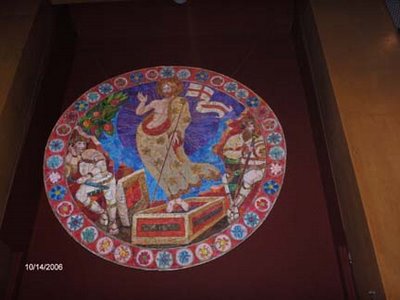
This last weekend I visited Walla Walla College. While there I noticed the piece of art displayed in the front of the church.
The Painting depicts the Resurrection, we see Jesus with wound marks rising above a casket like grave, holding the banner which appears to be a Crusader's flag and showing a soldier on each side asleep.
It is a nice piece of Art and the size is impressive as well as the talent of the artist. What bothers me about it is the Crusader's flag.
The most common reason today to avoid the crusader's flag is the offense that it seems to inspire among many Muslims. But I am not that politically correct to find that offensive, though it does surprise me that this is found on a college campus. As the Crusader's Cross is the source of Scandinavian Flags it is hard to disregard it for the sake of political correctness.

The flags of the Scandinavian countries, Sweden, Norway, Denmark, Finland, Iceland, and the Faroe Islands, are all based on the Crusader's Cross. In each case the upright part of the cross is closer to the hoist than to the free end of the flag. Each of the flags uses a combination of the colors white, red, blue, and gold. All of the flags have their origin in the Dannebrog, the "Danish cloth" which goes back to the 13th century... In order from left to right they are: Iceland, Finland, Norway, Sweden, the Faroe Islands, Åland, and Denmark.The Problem I have with the Crusader's flag is that the Crusades were a terrible misuse of Christianity. To imagine Jesus holding one of the Crusade banners just does not look right to me.
Another interesting element of the above art is the fact that Biblically the event of Christ arising and the soldiers falling back as if dead did not occur. In writing about this incident in reference to Matt. 28 the Expositor's Bible Commentary writes:
Too much speculative "theologizing" has accompanied some modern treatments of these verses. In particular there is nothing to suggest that the soldiers were in any sense pagan witnesses of the Resurrection. They neither heard the angel's words nor saw the risen Jesus; and they would shortly lie about what really had happened (vv. 11-15).Adventist art on the other hand as I recall often depicts Jesus coming forth from the tomb and soldiers falling down, at least in our children's books.
Matthew 28:2-5 There was a violent earthquake, for an angel of the Lord came down from heaven and, going to the tomb, rolled back the stone and sat on it. His appearance was like lightning, and his clothes were white as snow. The guards were so afraid of him that they shook and became like dead men. The angel said to the women, "Do not be afraid, for I know that you are looking for Jesus, who was crucified.


3 comments:
Great post!
The flag in the painting is the flag of St. George or St. Georges cross. It is also the flag of England. You can see it in the UK flag as well. Georgia and a few other countries have crusader crosses on their flags still.
I've been all those Nordic places save the Faeroe Islands and Iceland. Good times!
National flags have had religious connotations for other countries too... If anything flags are emblems of the state religion.
Crusaders are offensive yeah but you'd have to be pretty silly to point to the flags of those nordic and anglo-saxon countries and say they're anti-Islam since they still have their 800-1000 year or so old flags...
Great post!
Interesting observations, Ron.
You raise essential questions about how art and symbols provide religious and political meaning in various contexts.
Significantly, during the 2005 GC session, debate erupted over the inclusion of the word "cross" in the 28th doctrine. In some parts of the world, a cross represents very different things than it does in small town Americana.
The 2005 General Conference question about the cross was because Muslims and Jews found the cross offensive because it is Christian. So it was not really because the cross had a different meaning.
From AToday.com 2005 General Conference Session in St. Louis
Adventist Today Report 5
By: Dennis Hokama
The first delegate to raise an objection was Richard Elofer, President of the church of Israel, who objected to the use of the “cross” in the opening sentence (“By His cross Jesus triumphed over the forces of evil.”) because the cross is seen by Jews and Muslims as an object of Christian idolatry, and Muslims associate the cross with the crusades. As an alternative, he suggested “By his death . . .”
Responding for administration, Dr. Angel Rodriguez of the Bible Research Institute responded that when read in context, the cross should not be offensive. William Johnsson of the Adventist Review added that the use of the cross in this context was scriptural (citing Colossians 2:14) and therefore, if it offended others, well, too bad.
Paul Peterson, delegate from the South Pacific Division, stated that the South Pacific Division had studied the amendment and had concluded that the amendment was theologically wrong in two places and lacked a theology of prayer. Therefore, he said the South Pacific Division did not support the amendment. The specifics were as follows:
Atoday article
Post a Comment